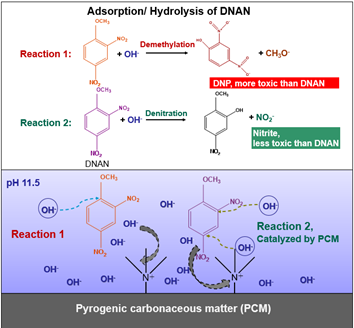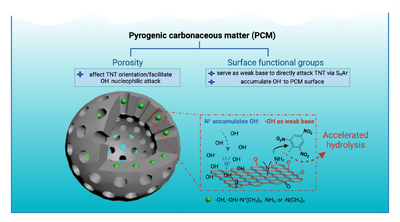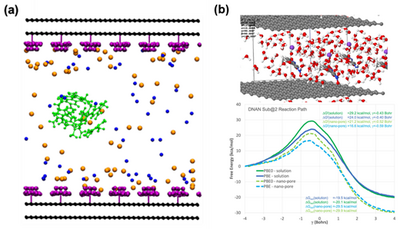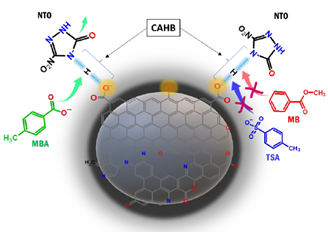Pyrogenic Carbonaceous Matter (PCM) Enhanced Alkaline Hydrolysis
High concentrations of munitions constituents (MC) residues, including legacy and insensitive high explosives (IHE), are commonly found in soil at Department of Defense (DoD) testing and training ranges, posing a significant risk to personnel and the environment. Many IHE are highly water soluble and can easily migrate from soil to groundwater and surface waters at DoD ranges. Therefore, there is a pressing need to maximize the sorption of legacy explosives and IHE, minimize their transport from DoD sites, and promote their decay whenever possible. The following article reports on a combined experimental and computational strategy to design and optimize pyrogenic carbonaceous matter (PCM, e.g., biochar and activated carbon) in ways that facilitate the retention and/or hydrolysis of legacy explosives and IHE that are of concern at DoD sites.
Contents
- 1 Introduction
- 2 Feasibility of PCM-facilitated Hydrolysis of MCs
- 3 Key Properties of PCM for MC Hydrolysis
- 4 Enhanced Hydrolysis of TNT and DNAN with Modified PCM
- 5 Computational Modeling
- 6 Exceptionally Strong NTO Adsorption on PCM
- 7 Performance of Modified PCM as Soil Amendments for IHE Post-Detonation Residues
- 8 References
- 9 See Also
Related Article(s):
- Munitions Constituents
- Munitions Constituents - Alkaline Degradation
- Munitions Constituents - Sorption
Contributors: Dr. Wenqing Xu
Key Resource(s):
- Experimental and Computational Study of Pyrogenic Carbonaceous Matter Facilitated Hydrolysis of 2, 4-Dinitroanisole (DNAN)[1]
Introduction
Historically, pyrogenic carbonaceous matter (PCM) has been used to remove contaminants from the aqueous phase by adsorption and/or complexation, but it was not believed to facilitate their degradation. A recent Strategic Environmental Research and Development Program (SERDP) project (ER19-1239) developed evidence that PCM not only adsorbs but also catalyzes the hydrolysis of some munition constituents, thus potentially reducing the need for regeneration or replacement of the adsorbent material and thereby reducing costs associated with management of these contaminants. This project found that PCM can facilitate MC degradation on carbon surfaces and thus free up adsorption sites, allowing PCM to remove a significantly greater mass of some MCs than would be possible by adsorption alone. Any MCs such as 3-Nitro-1,2,4-triazol-5-one (NTO) that are not susceptible to alkaline hydrolysis can be safely sequestered within the carbon amendment, decreasing their bioavailability to the surrounding environment. Furthermore, the tested technology boosts alkaline hydrolysis at near-neutral pH conditions rather than high pH conditions required by current methods (i.e., lime treatment). Bench studies using soils collected from Department of Defense ranges demonstrated enhanced adsorption affinity (over three orders of magnitude) for highly mobile IHEs such as NTO because the PCM amendments maintained their reactivity over consecutive additions of IHE formulations. The findings suggest that PCM has the potential to be developed and deployed as a reactive amendment for environmental remediation of MCs. Future efforts are needed to demonstrate these materials at full scale in the field.
Using a combined experimental and computational modeling approach, the structural features of MCs and PCM that are critical for PCM-facilitated hydrolysis were identified. Employing a polymer synthesis approach, the contribution of various functional groups and pore structures in promoting MC hydrolysis were delineated. The findings of this investigation have broad implications for reactive adsorbent design and remediation. For instance, the formation of σ complexes between -NH2 surface functional groups and nitroaromatics suggests that PCM rich in -NH2 functional groups could be easily poisoned due to the irreversible binding of 2,4,6-trinitrotoluene (TNT) or 2,4-dinitroanisole (DNAN). By contrast, quaternary ammonium (QA) functional groups could accumulate TNT, DNAN and hydroxide (OH-) in the same spatial region, potentially enabling hydrolysis of the MCs. Therefore, efforts can be focused on populating specific functional groups on carbon amendments for groundwater and soil remediation. For example, increasing the abundance of QA groups while decreasing the presence of -NH2 and -OH can reduce the need for PCM regeneration. This is because contaminants will be destroyed on PCM surfaces rather than filling up adsorption sites. Besides functional groups, the pore structures of adsorbents could also be adjusted to favor hydrolysis and specific pathways (see Figure 3).
A novel adsorption mechanism known as charge-assisted hydrogen bond (CAHB) formation was proposed to account for the exceptionally high affinity of PCM for MCs that do not undergo hydrolysis, such as NTO. The findings contradicted the conventional wisdom that polar organic anions (e.g., NTO) have little affinity for or are even repelled by hydrophobic carbonaceous sorbents. The results call attention to the need for new models or modification of existing models for the sorption of ionizable compounds in order to consider CAHB formation with sorbents. The findings also have potentially important implications for the use of carbons in environmental remediation more generally, particularly for strategies that enhance the retention of anionic contaminants that are otherwise highly mobile, such as nitrite, nitrate, phosphate, or some per- and polyfluoroalkyl substances (PFAS).
Feasibility of PCM-facilitated Hydrolysis of MCs

Results of this study suggest that hydrolysis of TNT, DNAN, and nitroguanidine (NQ), can be enhanced by the presence of various PCMs. The transformation of TNT by graphite powder, a model PCM, exhibited first-order decay kinetics, with an observed rate constant (kobs) of 0.258 ± 0.010 day-1 and a calculated half-life (t1/2) of 2.70 ± 0.10 days[2]. Slower degradation was observed for DNAN under the same conditions. Increasing the pH and the temperature enhanced the degradation kinetics of DNAN[1]. More importantly, results suggest that PCM accelerated DNAN decay by lowering the activation energy of DNAN hydrolysis by 54.3 ± 3.9%. NQ is a monoprotic acid in water with a reported pKa value of 12.8. NQ undergoes significant base hydrolysis at pH values as low as 11.5. This study showed that PCM pre-equilibrated with NQ initially accelerated NQ hydrolysis at three pH conditions (pH 11.0, 11.5, and 12.5) compared to the aqueous reaction. However, after a few hours, hydrolysis in the presence of PCM slowed down, whereas aqueous hydrolysis continued apace, indicating that the physical and chemical properties of PCMs play critical roles in controlling the hydrolysis of MCs.
Key Properties of PCM for MC Hydrolysis

To investigate the effect of PCM functional group identity and pore characteristics on MC hydrolysis, a PCM-like polymer (PLP) platform was developed to allow for delineating individual PCM properties’ contributions using a reductionist approach. PLPs exhibit properties that are similar to PCM: (i) large surface area and high microporosity, (ii) highly conjugated and amorphous, and (iii) superior affinity for apolar organic contaminants. Unlike PCM, the attributes of PLP can be individually tuned and made homogeneously throughout the polymer networks. Specifically, six PLPs were synthesized via cross-coupling chemistry with specific functionality (i.e., -OH, -NH2, -N(CH3)2, and -N(CH3)3+) and pore characteristics (i.e., mesopore, micropore). Different surface functional groups were incorporated into the PLPs by adapting the synthesis approach described in previous work[3]. The pore characteristics of PLP were controlled by rigid node-strut topology, where two polymers were obtained, one with exclusively mesopores and the other with a mixture of micropores and mesopores. This showed that -OH and -NH2 functional groups can serve as weak bases to facilitate TNT hydrolysis, whereas -N(CH3)3+ groups can increase the local pH by accumulating OH- near PCM surfaces. Moreover, the micropores of PCM seem capable of altering the chemical environment around TNT molecules (including their location and orientation) in such a way as to facilitate their hydrolysis. This study attempted to scrutinize the complex properties of PCM that promote surface hydrolysis, namely the functional group identity and pore characteristics.
Enhanced Hydrolysis of TNT and DNAN with Modified PCM
This investigation proposes that PCMs can affect the thermodynamics and kinetics of hydrolysis reactions by confining the reaction species near PCM surfaces, thus making them less accessible to solvent molecules and creating an environment with a weaker dielectric constant that favors nucleophilic substitution reactions. The addition of QA groups on the PCM surface can further accelerate MC hydrolysis. The performance of PCM toward DNAN hydrolysis was evaluated by comparing the MC decay kinetics across various PCM types, including unmodified PCMs such as almond shell char or activated carbon (AC)), and modified PCMs with physical or chemically attached QA groups. The results suggest that QA-modified activated carbon performed the best by reducing the half-life of DNAN to 2.5 days at pH 11.5 and 25°C while maintaining its reactivity over ten consecutive additions of DNAN[1]. TNT exhibited faster decay in samples containing QA-modified AC than unmodified AC, with an estimated half-life of 0.2 days and 1 day, respectively[3]. Nitrite was observed as one of the transformation products for both DNAN and TNT, suggesting the presence of PCM favored the denitration pathway. By contrast, demethylation, the preferred pathway in homogeneous solution, produces 2,4-dinitrophenol (DNP). Denitration catalyzed by PCM was advantageous when compared to demethylation because nitrite is less toxic than DNAN and DNP. Overall, the results suggest that further improvement of the PCM performance could be expected by tailoring its surface to increase the abundance of QA while decreasing the presence of -NH2 or -OH groups for the hydrolysis of MCs.
Computational Modeling

Further mechanistic insights were obtained by performing non-reactive molecular dynamics simulations on idealized pore structures. Upon the introduction of positively charged QA groups, the structure changed dramatically at the PCM interface. As the number of surface groups increased, the resulting density of OH- at the PCM surface increased by a factor of four relative to the density in the middle of the pore. Hence, the impact of the surface-bound cations was to attract OH- in competition with the neutralizing anions in the environment. In addition to driving the accumulation of OH-, the surface QA groups also impacted the distribution of TNT in the pore. At low QA surface coverage, TNT sought to adsorb on the exposed graphene. However, at sufficiently high QA surface coverage, TNT was blocked from lying flat on the graphene sheet and instead aggregated in the fluid away from the pore wall. The observation of TNT surface layering at intermediate charge densities was intriguing because it demonstrated the collection of TNT molecules close to the surface in the same spatial region where hydroxide was likewise accumulating relative to its concentration in the interstitial fluid. The molecular dynamics simulations provided evidence that the presence of the surface groups can play a role in accelerating TNT hydrolysis by acting to concentrate both TNT and hydroxide near the pore wall[3].
Ab Initio Molecular Dynamics/Molecular Mechanics (AIMD/MM) free energy simulations using expanded slabs and unit cells were also performed, focusing on the interaction of DNAN, hydroxide ions, Na+, and multiple water molecules sandwiched between two graphene layers[1]. The upper panel of Figure 3(b) provides a molecular snapshot from the AIMD/MM simulation, showcasing the intermediate stage of DNAN reacting with a hydroxide ion within a nano-pore structure. The lower panel depicts the reaction energy profiles for the hydrolysis of DNAN, both in bulk aqueous solution and within the nano-pore environment. The x-axis represents the reaction coordinate, a schematic representation of the progression from reactants to products through various transition states and intermediates. The y-axis corresponds to the Gibbs free energy changes (ΔG), providing insights into the thermodynamic favorability of each step in the pathway. Lower barriers corresponded to more kinetically accessible reactions. In the nano-pore environment, the energy barriers were significantly reduced, suggesting a catalytic effect due to confinement. This reduction was quantified by a decrease in ΔG of approximately 8 kcal/mol compared to the bulk solution, indicating that the reactions were not only more thermodynamically favorable but also kinetically accelerated in the nano-pore. In conclusion, the results demonstrate that nano-pore environments can significantly alter the hydrolysis mechanism of DNAN, leading to potentially less toxic products.
Exceptionally Strong NTO Adsorption on PCM

Results from this project suggest that NTO was chemically stable for up to at least a week in NaOH solution at pH 13.8[4]. Despite its highly polar and anionic character (pKa = 3.78), NTO exhibited unexpectedly strong sorption toward PCM at environmentally relevant pH conditions. This high affinity was partly due to the formation of an exceptionally strong negative charge-assisted hydrogen bond, or (−)CAHB, with weak acid functional groups on the carbon surface (Figure 4). The CAHB was identified by evaluating adsorption isotherms, pH adsorption edge plots, competitive sorption experiments, and pH drift experiments. The findings contradict the conventional view that polar organic anions have little affinity for or are even repelled by hydrophobic carbonaceous sorbents. The results call attention to the need for new models or modification of existing models for the sorption of ionizable compounds that consider CAHB formation with sorbents. The findings also have potential implications for the use of carbons in environmental remediation and catalysis, particularly for the design of strategies for the retention and degradation of highly mobile contaminants.
Performance of Modified PCM as Soil Amendments for IHE Post-Detonation Residues
Batch and column tests were conducted to evaluate the adsorption and hydrolysis of post-detonation residues of IMX-101 in three DoD range soils amended with modified PCMs[5]. Results indicated that adding PCMs enhanced the removal of NTO, NQ, and DNAN in soils compared to the soil controls, with enhancement factors ranging from 50 to 300. Consistent with previous results, NTO exhibited the highest partition coefficients (Kd) in PCM-amended soils compared to DNAN and NQ despite its highly polar and anionic character. Among various PCMs, QA-modified AC performed best, followed by unmodified AC and chars. The Kd values of NTO, NQ, and DNAN were slightly lower in the IMX-101 mixture than individually, possibly due to the adsorption competition from other constituents in IMX-101. The treatment was evaluated at pH 8, 10, and 12. No NTO decay was observed across the investigated pH range with or without PCM. By contrast, up to 13% of NQ was removed but only at pH > 10. Up to 90% DNAN decay occurred at pH 10 and 12 over 7 days in soils amended with modified AC. The 2% amendment dose was most effective, maintaining its adsorption capacity and reactivity over three consecutive IMX-101 additions. Column tests confirmed that 2% PCM addition significantly delayed the NTO, NQ, and DNAN breakthrough. The breakthrough volume (defined as treatment volume resulting in Concentrationout=0.1*Concentrationin) of NTO, NQ, and DNAN correlated with their Kd values obtained from the batch tests, where no retention was observed in the absence of PCM amendments. These findings highlight the feasibility of using modified PCM to simultaneously retain and transform IMX residues, providing a strategy for using reactive amendments in situ to sustain military operation and pollutant abatement.
References
- ^ 1.0 1.1 1.2 1.3 1.4 1.5 Seenthia, N.I., Bylaska, E.J., Pignatello, J.J., Tratnyek, P.G., Beal, S.A., Xu, W., 2024. Experimental and Computational Study of Pyrogenic Carbonaceous Matter Facilitated Hydrolysis of 2, 4-Dinitroanisole (DNAN). Environmental Science and Technology, 58(21), pp. 9404–9415. doi: 10.1021/acs.est.4c01069 Article pdf
- ^ Ding, K., Byrnes, C., Bridge, J., Grannas, A., Xu, W., 2018. Surface-promoted hydrolysis of 2,4,6-trinitrotoluene and 2,4-dinitroanisole on pyrogenic carbonaceous matter. Chemosphere, 197, pp. 603-610. doi: 10.1016/j.chemosphere.2018.01.038
- ^ 3.0 3.1 3.2 3.3 3.4 Li, Z., Jorn, R., Samonte, P.R.V., Mao, J., Sivey, J.D., Pignatello, J.J., Xu, W., 2022. Surface-catalyzed hydrolysis by pyrogenic carbonaceous matter and model polymers: An experimental and computational study on functional group and pore characteristics. Applied Catalysis B: Environment and Energy, 319, article 121877. doi: 10.1016/j.apcatb.2022.121877 Manuscript pdf
- ^ 4.0 4.1 Abdelraheem, W., Meng, L., Pignatello, J.J., Seenthia, N.I., Xu, W., 2024. Participation of Strong H-Bonding to Acidic Groups Contributes to the Intense Sorption of the Anionic Munition, Nitrotriazolone (NTO) to the Carbon, Filtrasorb 400. Environmental Science and Technology, 58(46), pp. 20719-20728. doi: 10.1021/acs.est.4c07055
- ^ Seenthia, N.I., Abdelraheem, W., Beal, S.A., Pignatello, J.J., Xu, W., 2025. Simultaneous adsorption and hydrolysis of insensitive munition compounds by pyrogenic carbonaceous matter (PCM) and functionalized PCM in soils. Journal of Hazardous Materials, 494, article 138501. doi: 10.1016/j.jhazmat.2025.138501